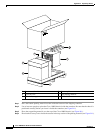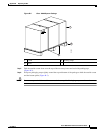
Glossary
GL-6
Cisco 10008 Router Hardware Installation Guide
OL-0659-13
G
GBIC
Gigabit Ethernet converter. An interface module used by gigabit Ethernet and Fibre Channel to convert
the serial electrical signals to the transmission medium’s physical layer signalling, which is typically
optical. GBIC modules can be hot swapped and contain ID and system information that a switch or
router can use to determine the network device's capabilities. Different GBICs handle different types
of fiber cable. See 1000BaseLX/LH, 1000BaseSX, and 1000BaseZX.
Gigabit Ethernet
Gigabit Ethernet. Ethernet running at a transmission speed of 1 billion bits per second.
Gigabit Interface
Converter
See GBIC.
H
Hot swapping
Feature that permits the addition, replacement, or removal of cards without interrupting the system
power, entering console commands, or causing other software or interfaces to shut down. Sometimes
called online insertion and removal (OIR).
I
IEEE
Institute of Electrical and Electronics Engineers. Professional organization whose activities include the
development of communications and network standards. IEEE LAN standards are the currently
predominant LAN standards.
IEEE 802.3
IEEE LAN protocol that specifies an implementation of the physical layer and the MAC sublayer of
the data link layer. IEEE 802.3 uses CSMA/CD access at a variety of speeds over a variety of physical
media. Extensions to the IEEE 802.3 standard specify implementations for Fast Ethernet and gigabit
Ethernet.
Institute of Electrical
and Electronics
Engineers
See IEEE.
Intermediate reach
See IR.
Internet service
provider
See ISP.
IOS
Internet Operating System. See Cisco IOS.
IP
Internet Protocol. Network layer protocol in the TCP/IP stack offering a connectionless internetwork
service. IP provides features for addressing, type-of-service specification, fragmentation and
reassembly, and security. Defined in RFC 791.
IP multicast
Routing technique that allows IP traffic to be propagated from one source to a number of destinations
or from many sources to many destinations. Rather than sending one packet to each destination, one
packet is sent to a multicast group identified by a single IP destination group address.


















